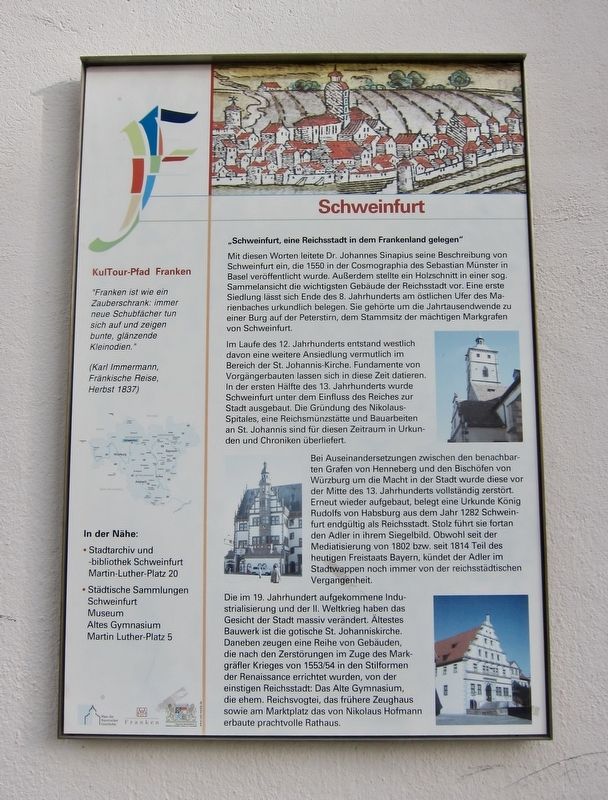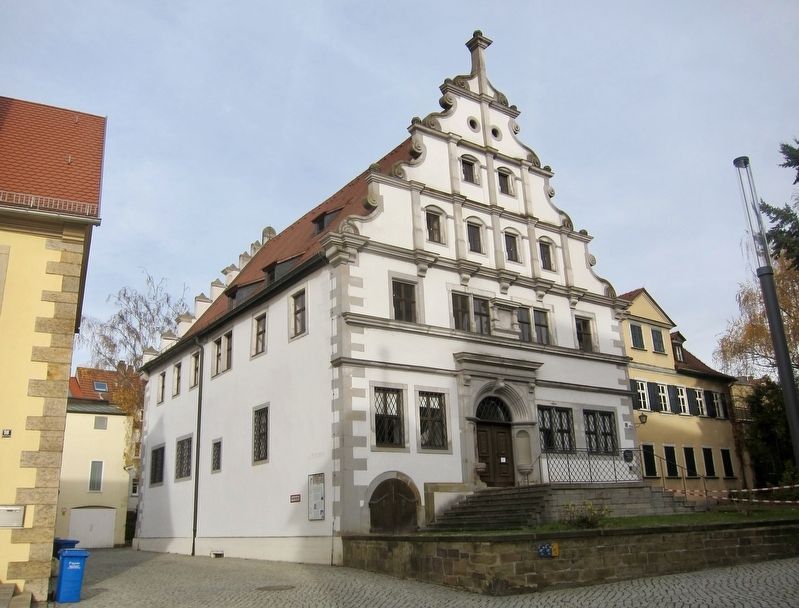Schweinfurt
Mit diesen Worten leitete Dr. Johannes Sinapius seine Beschreibung von Schweinfurt ein, die 1550 in der Cosmographia des Sebastian Münster in Basel veröffentlicht wurde. Außerdem stellte ein Holzschnitt in einer sog. Sammelansicht die wichtigsten Gebäude der Reichsstadt vor. Eine erste Siedlung lässt sich Ende des 8. Jahrhunderts am östlichen Ufer des Marienbaches urkundlich belegen. Sie gehörte um die Jahrtausendwende zu einer Burg auf der Peterstirn, dem Stammsitz der mächtigen Markgrafen von Schweinfurt.
Im Laufe des 12. Jahrhunderts entstand westlich davon eine weitere Ansiedlung vermutlich im Bereich der St. Johannis-Kirche. Fundamente von Vorgängerbauten lassen sich in diese Zeit datieren. In der ersten Hälfte des 13. Jahrhunderts wurde Schweinfurt unter dem Einfluss des Reiches zur Stadt ausgebaut. Die Gründung des Nikolaus-Spitales, eine Reichsmünzstätte und Bauarbeiten an St. Johannis sind für diesen Zeitraum in Urkunden und Chroniken überliefert.
Bei Auseinandersetzungen zwischen den benachbarten Grafen von Henneberg und den Bischöfen von Würzburg um die Macht in der Stadt wurde diese vor der Mitte des 13. Jahrhunderts vollständig zerstört. Erneut wieder aufgebaut, belegt eine Urkunde König Rudolfs von Habsburg aus dem Jahr 1282
Schwein- furt endgültig als Reichsstadt. Stolz führt sie fortan den Adler in ihrem Siegelbild. Obwohl seit der Mediatisierung von 1802 bzw. seit 1814 Teil des heutigen Freistaats Bayern, kündet der Adler im Stadtwappen noch immer von der reichsstädtischen Vergangenheit.Die im 19. Jahrhundert aufgekommene Industrialisierung und der II. Weltkrieg haben das Gesicht der Stadt massiv verändert. Ältestes Bauwerk ist die gotische St. Johanniskirche. Daneben zeugen eine Reihe von Gebäuden, die nach den Zerstörungen im Zuge des Markgräfler Krieges von 1553/54 in den Stilformen der Renaissance errichtet wurden, von der einstigen Reichsstadt: Das Alte Gymnasium, die ehem. Reichsvogtei, das frühere Zeughaus sowie am Marktplatz das von Nikolaus Hofmann erbaute prachtvolle Rathaus.
-
(English translation:) "Schweinfurt, an imperial city located in Franconia..."
And so with these words, Dr. Johannes Sinapius began his description of the city of Schweinfurt that was published in 1550 in the Cosmographia of Sebastian Münster that was published in Basel, that also included a woodcut showing an overall view of the most important buildings of the imperial city. A first settlement can be documented on the eastern bank of the Marienbach (stream) at the end of the 8th century. At the turn of the millennium it belonged to a castle on Peterstirn,
the ancestral seat of the powerful margraves of Schweinfurt.In the course of the 12th century, another settlement arose to the west of it, probably in the area of the St. John's church. Foundations of previous buildings can be dated to this time. In the first half of the 13th century, under the influence of the empire, Schweinfurt grew into a city. The founding of the Nikolaus Hospital, an imperial mint, and construction work on St. John's have been recorded in documents and chronicles for this period.
As a result of the disputes between the neighboring Counts of Henneberg and the Bishops of Würzburg for power in the city, the city was completely destroyed before the mid-13th century. After reconstruction, a document from 1282 from King Rudolf von Habsburg finally confirms Schweinfurt's status as an imperial city. From then on Schweinfurt has proudly displayed the imperial eagle in its seal. Since the "mediatization" of 1802, and since becoming part of the Free State of Bavaria in 1814, the eagle is still present in the city coat of arms as a reminder of the Schweinfurt's past status as an imperial city.
The industrialization that emerged in the 19th century and the Second World War both changed the face of the city changed massively. The oldest building is the Gothic St. John's Church. After that, there are also a number of other buildings that were built
in the Renaissance style after the destruction of Markgräfler War of 1553-54 that testify to the city's status as an imperial city: the old higher school, the former Imperial Offices, the former armory, as well as the magnificent city hall on the market square, built by Nikolaus Hofmann.
Topics. This historical marker is listed in this topic list: Settlements & Settlers.
Location. 50° 2.786′ N, 10° 13.95′ E. Marker is in Schweinfurt, Bayern (Bavaria). Marker is at the intersection of Bodengasse and Martin-Luther-Platz, on the right when traveling north on Bodengasse. Touch for map. Marker is in this post office area: Schweinfurt BY 97421, Germany. Touch for directions.
Other nearby markers. At least 8 other markers are within walking distance of this marker. Dr. Martin Luther (within shouting distance of this marker); Hartmann Jalousie und Rolladen / Hartmann's Shutters and Blinds (within shouting distance of this marker); Schweinfurter Schlachtschüssel / The Schweinfurt “Slaughter Pot” (about 90 meters away, measured in a direct line); Schopperschen Haus / Schopper's House (about 120 meters away); Raven Hotel / Hotel zum Raben (about 180 meters away); Ehemalige Rückert-Buchhandlung / The Former Rueckert Bookshop (about 210 meters away); Das Zeughaus - Städtisches Waffenarsenal / The Armory - Municipal Arsenal (about 210 meters away); Engelbert Fries and Wilhelm Höpflinger (about 210 meters away). Touch for a list and map of all markers in Schweinfurt.
Also see . . . History of Schweinfurt (City of Schweinfurt). (Submitted on December 22, 2019.)
Credits. This page was last revised on January 28, 2022. It was originally submitted on December 22, 2019, by Andrew Ruppenstein of Lamorinda, California. This page has been viewed 109 times since then and 14 times this year. Photos: 1, 2. submitted on December 22, 2019, by Andrew Ruppenstein of Lamorinda, California.

